Key takeaways
- Voter turnout initiatives focus on outreach, education, and mobilizing young voters through social media, helping to increase participation.
- Louisiana’s closed primary system and strict voter ID laws can discourage participation among independent and marginalized voters.
- Significant fluctuations in voter turnout highlight the need for increased civic engagement, especially in local elections.
- Recommendations to improve turnout include education campaigns, enhancing accessibility at polling places, and fostering community involvement in the voting process.
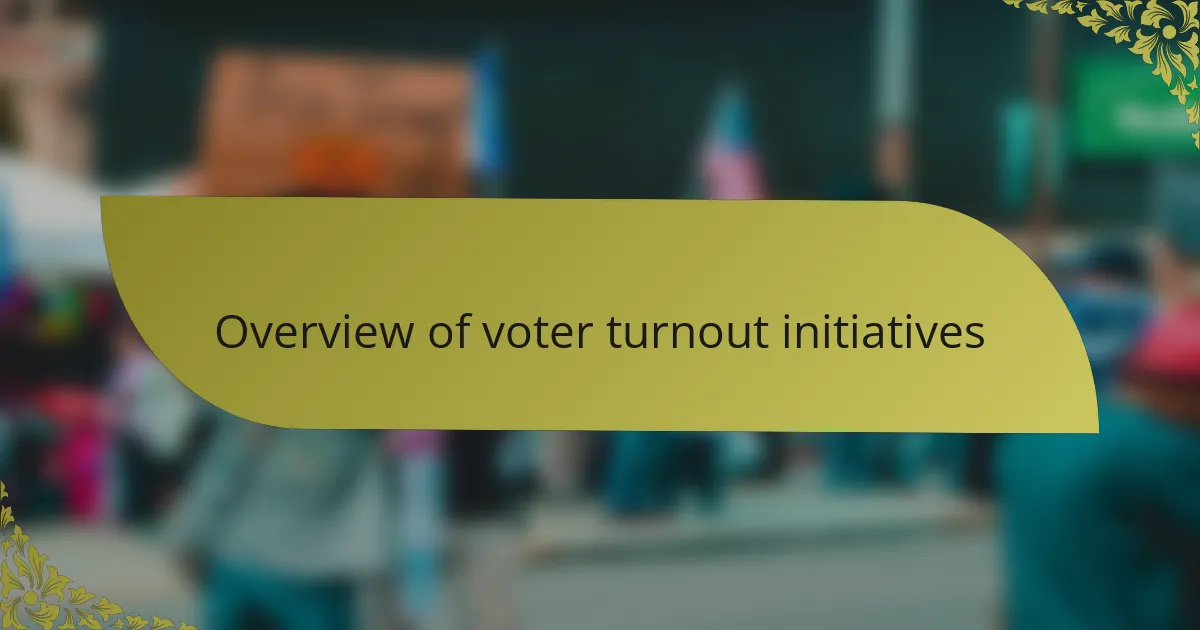
Overview of voter turnout initiatives
Voter turnout initiatives have gained traction across the United States, with Louisiana being no exception. I remember my own excitement during election season; it’s energizing to see community efforts aimed at increasing participation. These initiatives often include outreach programs, simplifying registration processes, and mobilizing voters through various channels.
One of the standout efforts I’ve noticed is the focus on young voters. Engaging students on campuses can really make a difference, don’t you think? I’ve seen firsthand how passionate these young individuals can be about issues that matter to them. Such initiatives often use social media platforms to spark interest and get young people involved, which just feels so vital in today’s digital age.
Moreover, some initiatives work closely with local organizations to bridge gaps in voter education. It’s crucial that we understand the voting process and its impact on our lives. I often wonder, how can we ensure that everyone feels their voice truly matters? Encouraging open discussions and providing information can empower individuals, making them more inclined to participate.
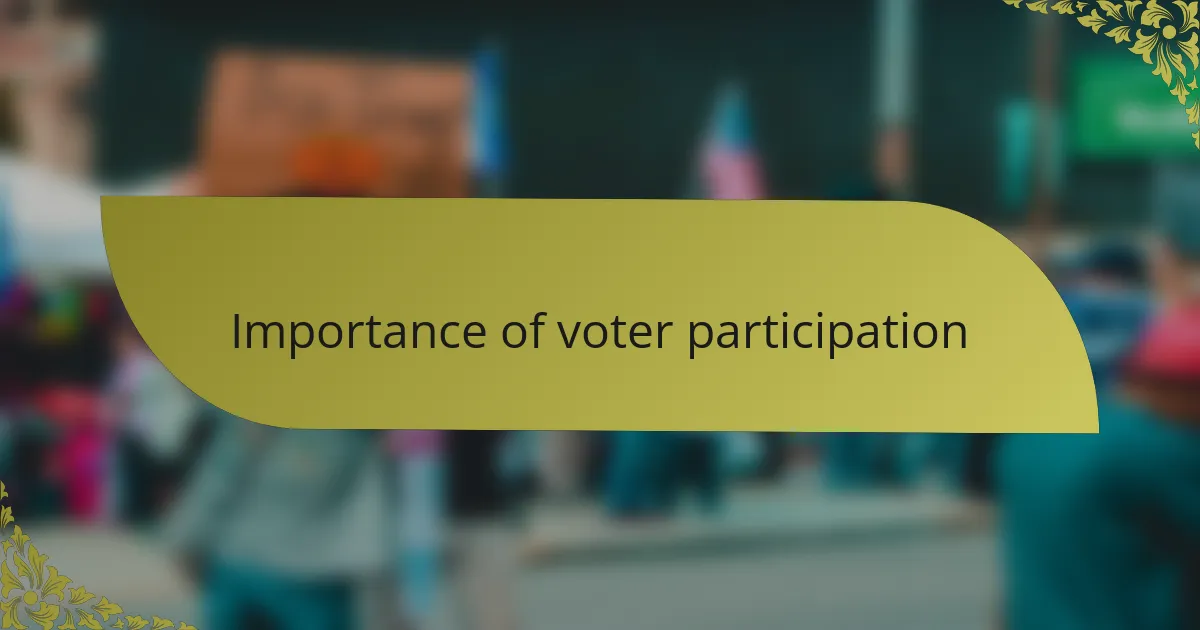
Importance of voter participation
Voter participation is crucial for a vibrant democracy, especially in a state like Louisiana. I’ve seen how transformative it can be when communities unite to express their opinions through the ballot. It’s not just about casting a vote; it’s about making our voices heard and ensuring our concerns are represented in government.
States experience higher voter turnout when there are accessible initiatives in place, such as outreach programs and simplified voting procedures. For me, volunteering with local organizations that promote voter registration has been eye-opening. I felt the pride of helping individuals understand that their votes truly matter. When I see someone who initially hesitated to vote transform into an engaged participant, it reaffirms my belief in the power of collective action.
- Civic engagement reflects the health of a democracy.
- Increased voter participation leads to better representation of diverse communities.
- Initiatives like early voting and mail-in ballots make it easier for everyone to participate.
- Educated voters contribute to informed decision-making in elections.
- Increasing turnout can drive changes in policies that directly affect local issues.
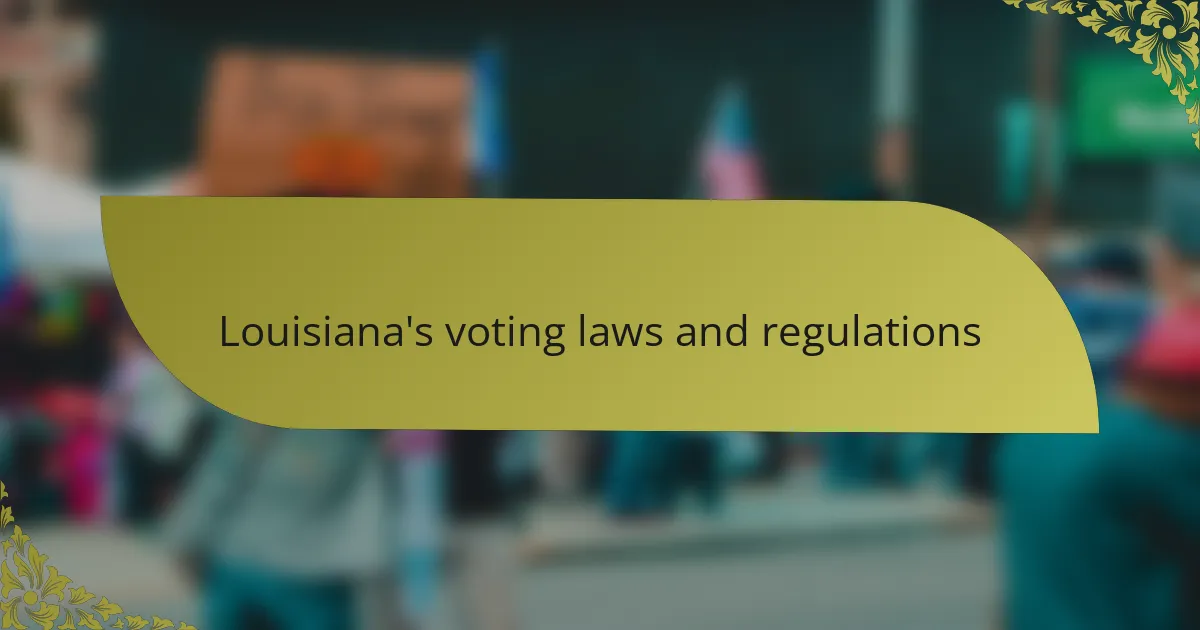
Louisiana’s voting laws and regulations
Louisiana’s voting laws and regulations are unique, shaped by the state’s rich history and cultural influences. For instance, Louisiana has a closed primary election system, which means that only registered party members can vote in their party’s primary elections. This can sometimes create challenges for independent voters who want a say in the choices being made before the general election.
One aspect that resonates with me is the emphasis on voter ID laws in Louisiana. While the intention is to protect the integrity of the election process, I often wonder if these regulations unintentionally discourage participation, especially among marginalized groups. My experience speaking with community members reveals that many feel overwhelmed by the requirements and therefore hesitant to vote.
Here’s a comparison of voter registration and ID requirements in Louisiana versus a few other states:
| State | Voter ID Required |
|---|---|
| Louisiana | Yes, photo ID required |
| California | No ID required, but registration needed |
| Texas | Yes, photo ID required |
| New York | No ID required, but registration needed |
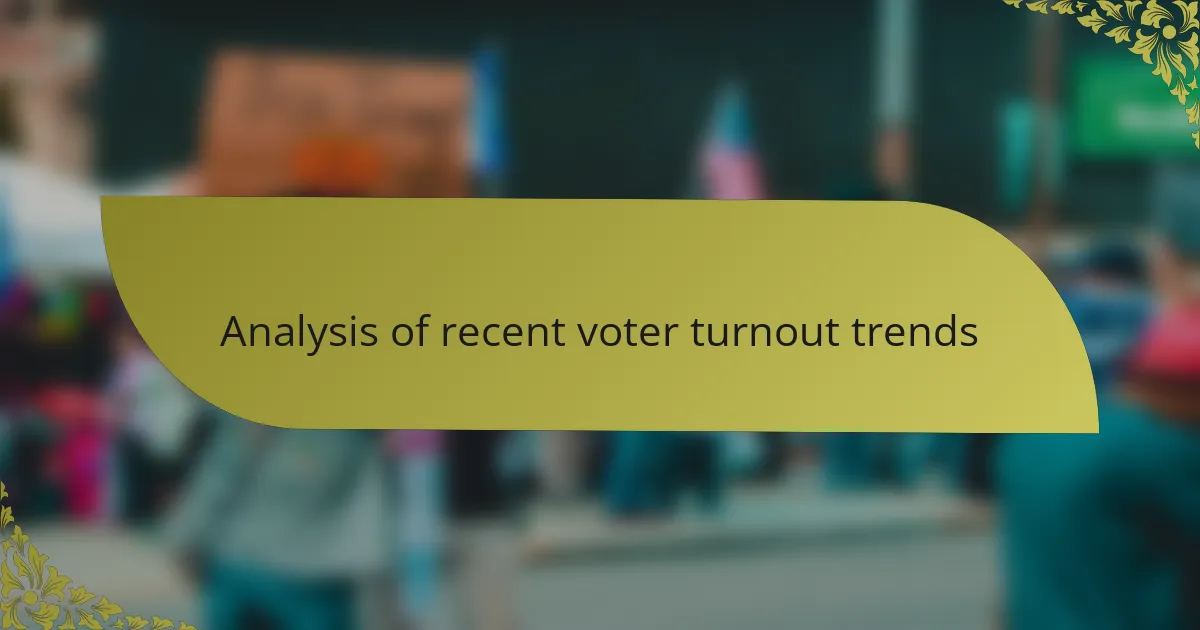
Analysis of recent voter turnout trends
In analyzing recent voter turnout trends in Louisiana, I’ve observed a significant fluctuation in participation rates across various elections. For instance, during the 2020 presidential election, the turnout reached approximately 66.7%, a notable increase from prior years. However, in local elections, participation often drops sharply, sometimes dipping below 30%. This disparity raises questions about civic engagement at different levels of governance.
I’ve personally felt the impact of these trends. When I voted in the last few elections, I noticed that many of my peers were unsure of candidates or measures on the ballot, which could explain some of the low turnout in local contests. It makes me wonder what tools or initiatives could help bridge that gap and encourage more informed participation.
| Election Year | Voter Turnout (%) |
|---|---|
| 2020 Presidential Election | 66.7 |
| 2018 Midterms | 51.2 |
| 2021 Local Elections | 28.5 |
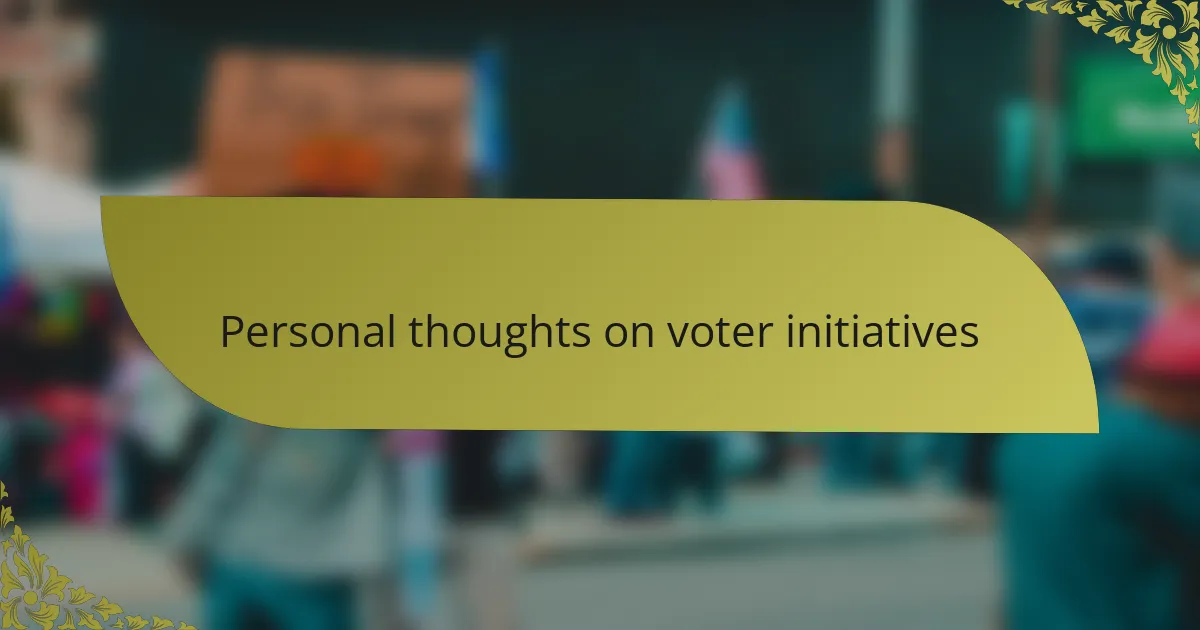
Personal thoughts on voter initiatives
When I think about voter turnout initiatives, I can’t help but feel a mix of hope and frustration. In my experience, grassroots efforts often create an incredible sense of community, uniting people for a common cause. Yet, I’ve also seen how systemic barriers can dampen this enthusiasm and discourage participation from historically disenfranchised groups.
There’s something poignant about seeing friends and neighbors engage in discussions about the impact of voting, but it’s disheartening when those conversations don’t translate into action. Initiatives that genuinely address accessibility—like transportation services, information campaigns in multiple languages, and simplifying the registration process—can make a considerable difference.
- Increasing awareness through local outreach programs can bridge the gap between apathy and action.
- Providing clear, simple resources online can empower first-time voters.
- Organizing community events around voting can create excitement and foster participation.
- Collaborating with schools to educate young voters can pave the way for future engagement.
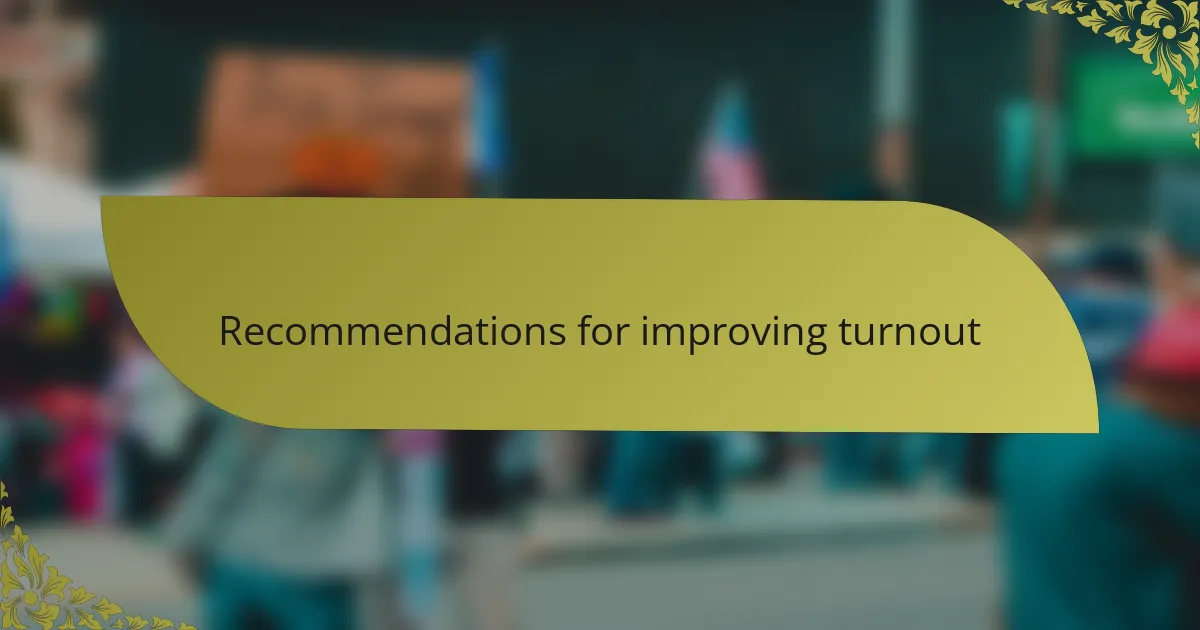
Recommendations for improving turnout
To improve voter turnout, I believe that a multi-faceted approach is essential. For instance, implementing education campaigns about the voting process can demystify the experience for first-time voters. I remember when I first attempted to vote; I felt lost in the complexities of registration and polling locations. Simple guides distributed through schools and local organizations could make a real difference.
Moreover, enhancing accessibility is crucial. Ensuring that polling places are more accessible to people with disabilities and offering extended voting hours can encourage participation. I’ve seen friends who once hesitated to vote because of logistical barriers happily engage when these considerations are made.
A focus on community engagement is equally important. Local governments can foster a sense of ownership by involving community leaders in promoting the significance of voting. From my experience, when people see their neighbors discussing the importance of their vote, it creates a ripple effect that can lead to higher turnout rates.
| Recommendation | Description |
|---|---|
| Education Campaigns | Focus on providing clear and accessible information about the voting process, especially for first-time voters. |
| Accessibility Improvements | Enhance physical access to polling places and extend voting hours to accommodate more voters. |
| Community Engagement | Involve local leaders to promote the importance of voting and create a communal sense of responsibility. |